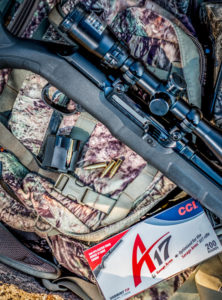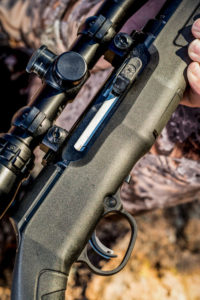
In this Savage A17 review, Jon R. Sundra explains how the first delayed blowback semi-auto action chambered in .17 HMR rimfire operates and performs at the bench.
Why The Savage A17 Is A Different Kind Of Rimfire:
- First successful .17 HMR semi-auto rifle
- Delayed blowback action makes it possible for the AR17 to relyable cycle
- Feeds from a 10-round rotary magazine
- Extremely accurate shot to shot
- Suitable as a target rifle or a hunter
 When the .17 Winchester Super Magnum (WSM) rimfire cartridge debuted two years ago, it did so not in a Winchester, but in the Savage B-Mag, a rifle designed from scratch around this hottest of rimfires. This year Savage pulled a similar move by working with CCI to come up with the first affordable semi-auto rifle chambered for the .17 Hornady Magnum Rimfire (HMR).
When the .17 Winchester Super Magnum (WSM) rimfire cartridge debuted two years ago, it did so not in a Winchester, but in the Savage B-Mag, a rifle designed from scratch around this hottest of rimfires. This year Savage pulled a similar move by working with CCI to come up with the first affordable semi-auto rifle chambered for the .17 Hornady Magnum Rimfire (HMR).
Savage and CCI, as you may know, are among the dozens of firearms-related companies now under the Vista Outdoor family. For this cooperative project, the CCI people developed a special load, A17 Varmint Tip, which boasts a 2,650 fps muzzle velocity for its 17-grain polymer tipped bullet—that’s 100 fps faster than all other similar loads offered by Hornady, Winchester, Remington, PMC and even CCI.
The .17 HMR was introduced back in 2002, so why did it take 13 years for someone to come up with a self-loader for this highly popular cartridge? Good question. The answer lies in the fact that no existing semi-auto rimfire rifle of sporting configuration could handle it. Even though the cartridge had a maximum average breech pressure (MABP) only 2,000 psi more than the .22 LR and .22 Magnum (WMR), and the fact that a few existing semi-autos were successfully adapted to the latter, the .17 HMR posed special challenges.
All existing semi-auto rimfire rifles employ straight blowback actions, which are not capable of handling high-intensity centerfire pistol and rifle calibers. With a blowback there is no locking mechanism per se, and only the spring(s) that power the bolt keep the action closed. Upon ignition, the equal and opposite reaction of launching a bullet forward has the cartridge case pushing backwards.
The mass of the bolt itself and its spring provide enough resistance to keep the action closed the few microseconds it takes for the bullet to exit the muzzle and the pressure to drop.
 With the .17 HMR, however, things become more complicated because we’re talking about a bullet weight range of 15.5 to 20 grains—that’s half the weight (and half the resistance) of the 40-grain payload of the .22 LR or .22 Magnum. As a result, the higher pressures, higher bullet velocity and greater bolt thrust were different enough that existing actions were not safely adaptable. To do it right required a new action, and apparently no major American arms manufacturer thought the demand for a semi-auto .17 HMR was enough to warrant the investment…at least not for 13 years, anyway.
With the .17 HMR, however, things become more complicated because we’re talking about a bullet weight range of 15.5 to 20 grains—that’s half the weight (and half the resistance) of the 40-grain payload of the .22 LR or .22 Magnum. As a result, the higher pressures, higher bullet velocity and greater bolt thrust were different enough that existing actions were not safely adaptable. To do it right required a new action, and apparently no major American arms manufacturer thought the demand for a semi-auto .17 HMR was enough to warrant the investment…at least not for 13 years, anyway.
Enter the A17, which is based on a delayed blowback action. There are many ways to keep the action closed a few microseconds longer, but all delayed blowbacks employ the same principle: The bolt performs some other operation before it can overcome the inertia of the bolt and spring and begins its rearward movement.
Get Even More Savage:
- The Revolutionary Savage 99
- Savage Model 10 GRS Rifle Goes The Distance … Then Some
- Are The Savage 212 And Savage 220 Among The Best Slug Guns?
- Savage MSR 15 Valkyrie Takes Flight
With the A17 there’s a collapsible lug housed in the top surface of the bolt that engages a slot in the ceiling of the receiver. The rear surfaces of the lug and the recess it bears against are angled to form a cam surface, which acts like an ordinary door latch. The rearward force exerted on the bolt forces the lug to collapse, allowing the bolt to open and move to the rear. It’s really quite a complicated mix of mass, resistance and timing—enough that it took the folks at Savage 2½ years of R&D to get it right.
 The A17 sent to us for review weighed 5.4 pounds and measured 42 inches in length. It feeds from a 10-round rotary magazine that fits flush with the belly of the stock. The free-floated, 22-inch barrel is button-rifled with a 1:9-inch twist and tapers to .610 at the muzzle, making it fairly stout for a .17 caliber. The safety is of the cross bolt type, housed in the forward portion of the trigger guard bow and therefore similar to those found on most pump and semi-auto shotguns. The injection-molded polymer stock is of the straight comb classic style with just a slight ¼-inch drop from the point of the comb to the rubber butt-padded heel. Pre-installed Weaver-type scope ring bases are standard, as is Savage’s AccuTrigger, which is user-adjustable down to 2.5 lbs.
The A17 sent to us for review weighed 5.4 pounds and measured 42 inches in length. It feeds from a 10-round rotary magazine that fits flush with the belly of the stock. The free-floated, 22-inch barrel is button-rifled with a 1:9-inch twist and tapers to .610 at the muzzle, making it fairly stout for a .17 caliber. The safety is of the cross bolt type, housed in the forward portion of the trigger guard bow and therefore similar to those found on most pump and semi-auto shotguns. The injection-molded polymer stock is of the straight comb classic style with just a slight ¼-inch drop from the point of the comb to the rubber butt-padded heel. Pre-installed Weaver-type scope ring bases are standard, as is Savage’s AccuTrigger, which is user-adjustable down to 2.5 lbs.
Another member of the Vista Outdoor Group is Weaver, so it was not coincidental that along with the A17 we received a KASPA (an Indian word meaning “clear vision”) 3-9x40mm rimfire scope and Weaver rings. This particular scope comes with three elevation dials calibrated to the 40-grain trajectories of the .22 LR and .22 Mag., and for the 17-grain polycarbonate-tipped bullets of the .17 HMR. Zeroed-in dead on at 100 yards, the 17-grain bullets will impact about 2 inches low at 150, and 6½ inches low at 200, which is really about the practical limit of this little cartridge. Of course with the HMR turret installed, you simply dial those respective distances and hold dead on. With the slightly flatter trajectory of the A17 Varmint Tip load, we found those respective points of impact to be about ½ inch higher at 150 and 1 inch higher at 200—not enough to worry about for general pest-shooting purposes. It should be noted that all existing .17 HMR loads, which range from 15.5 to 20 grains, are safe to fire in this gun.
 All told we put nearly 200 rounds through the test gun, which, if not a pre-production example, was of the first production run. As such, we had three failures to feed. Two magazines were provided, and if there is a trick to charging them, I failed to discover it. I consider myself rather dexterous, but I found stuffing 10 rounds into these magazines rather challenging.
All told we put nearly 200 rounds through the test gun, which, if not a pre-production example, was of the first production run. As such, we had three failures to feed. Two magazines were provided, and if there is a trick to charging them, I failed to discover it. I consider myself rather dexterous, but I found stuffing 10 rounds into these magazines rather challenging.
Also, on several occasions, firing the first shot had the magazine drop out of the rifle. This is in spite of the fact that, after the first such occurrence, I really slapped it home and got an audible click doing so. Again, this was early production for both rifle and ammo, so I fully expect such teething glitches to be addressed. Accuracy was more than acceptable, though the two standard loads proved slightly more accurate than the A17 ammo. The best group (.75 inches) came with Hornady’s 17-grain V-Max load.
Savage A17
Type: Delayed blowback,
semi-automatic
Caliber: .17 HMR
Barrel: 22 in., 1:9-in. twist,
button-rifled
Overall Length: 42 in.
Weight: 5.4 lbs.
Stock: Injection-molded polymer,
black matte finish
Sights: Drilled and tapped for optics
Trigger: Savage AccuTrigger,
adjustable to 2.5 lbs.
Capacity: 10 rounds
MSRP: $465
Manufacturer: SavageArms.com
This gun review appeared in the October 2015 issue of Gun Digest the Magazine.
Related Video:
Small Caliber, Big Questions: Dive Into .17 HMR
- Breaking Down .17 HMR vs .22 Mag Accuracy for Target Shooting
- .17 HMR vs .17 WSM Accuracy – Which is More Precise?
- A Guide to Choosing the Best .17 HMR Ammo
- Top Picks for the Most Accurate .17 HMR Rifle
- A Look at the Best .17 HMR Pistols Available Today

Next Step: Get your FREE Printable Target Pack
Enhance your shooting precision with our 62 MOA Targets, perfect for rifles and handguns. Crafted in collaboration with Storm Tactical for accuracy and versatility.
Subscribe to the Gun Digest email newsletter and get your downloadable target pack sent straight to your inbox. Stay updated with the latest firearms info in the industry.

![Best Concealed Carry Guns In 2025 [Field Tested] Wilson Combat EDC X9S 1](https://gundigest.com/wp-content/uploads/Wilson-Combat-EDC-X9S-1-324x160.jpg)


![Best 9mm Carbine: Affordable PCCs [Tested] Ruger Carbine Shooting](https://gundigest.com/wp-content/uploads/Ruger-Carbine-Shooting-100x70.jpg)
![Best AR-15: Top Options Available Today [Field Tested] Harrington and Richardson PSA XM177E2 feature](https://gundigest.com/wp-content/uploads/Harrington-and-Richardson-PSA-XM177E2-feature-100x70.jpg)

I have the A17 .. nice gun .. insert clip with bolt open minimizes clip drop.
Alexanderarms .. reviews still mention case breaches in your gun, but do mention the gun can handle it .. still IMO unsafe / unsat.
Cases exploding in the breach is why the Savage A17 was developed .. and it works for me.
Hey Gun Digest, you say “The .17 HMR was introduced back in 2002, so why did it take 13 years for someone to come up with a self-loader for this highly popular cartridge?” It didn’t take 13 years. Alexander Arms was in development of a semi-automatic AR-15 .17 HMR in 2008 and we were selling proven, reliable, high-quality rifles to the public in 2011, well before the A17 even entered development, based on your information. Here’s a blurb in a May 2012 Guns & Ammo article.
Check out what we have.